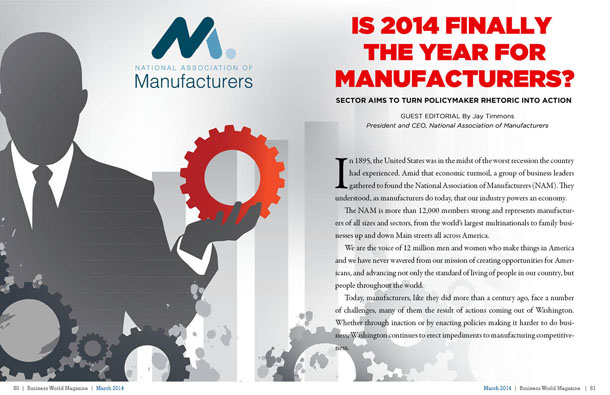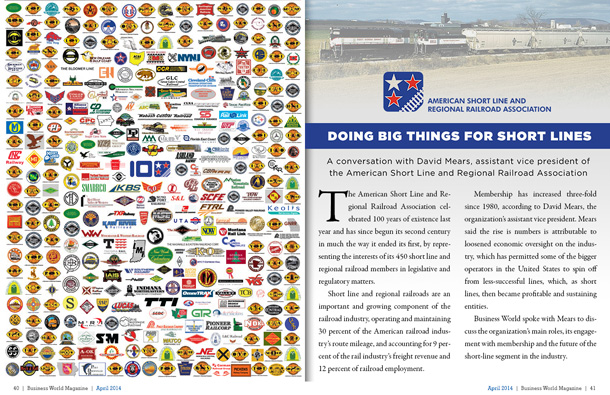
Is 2014 Finally the Year for Manufacturers?
Sector aims to turn policymaker rhetoric into action

GUEST EDITORIAL
By Jay Timmons
President and CEO, National Association of Manufacturers
In 1895, the United States was in the midst of the worst recession the country had experienced. Amid that economic turmoil, a group of business leaders gathered to found the National Association of Manufacturers (NAM). They understood, as manufacturers do today, that our industry powers an economy.
The NAM is more than 12,000 members strong and represents manufacturers of all sizes and sectors, from the world’s largest multinationals to family businesses up and down Main streets all across America.
We are the voice of 12 million men and women who make things in America and we have never wavered from our mission of creating opportunities for Americans, and advancing not only the standard of living of people in our country, but people throughout the world.
Today, manufacturers, like they did more than a century ago, face a number of challenges, many of them the result of actions coming out of Washington. Whether through inaction or by enacting policies making it harder to do business, Washington continues to erect impediments to manufacturing competitiveness.
The good news is that manufacturers can change the status quo. The nation is paying attention to manufacturing, and as a result, our sector has a unique opportunity to turn policymakers’ rhetoric into action on a number of key policy priorities.
Trade: Completing new trade agreements are of the utmost urgency. As other countries are aggressively entering into new trade agreements, the United States is standing still, having failed to complete any new trade measures since the 2011 agreements with Korea, Colombia and Panama. Manufacturers need policies that would help them enter and expand into new markets abroad so they can reach the 95 percent of consumers who live outside the United States. Although the president has championed the multiple economic benefits of exports – setting ambitious goals like doubling exports by 2015 – he needs to lead efforts to approve trade promotion authority (TPA), so the administration and Congress can enact new trade agreements efficiently. The pending Trans-Pacific Partnership, for example, would boost U.S. exports significantly and add jobs, yet could stall in Congress without TPA.
Infrastructure: Manufacturers also need a dynamic intermodal infrastructure system to replace our current infrastructure, which is badly outdated and critically needs repair. We rely on efficient transportation systems to move our products to and from market, not just in the United States but also abroad. Congress can begin to fix this by completing legislation to modernize our ports and waterways and by reauthorizing transportation funding to strengthen the nation’s surface transportation systems.
Energy: Manufacturers’ recent strength is largely attributable to the boom in domestic energy production. The shale revolution is attracting investment to our shores and helping to revitalize industries that we had all but given up on in the United States.
Yet, obstacles that make it harder to tap abundant North American energy continue to spring up. A number of proposed regulations would drive down demand for energy resources, such as coal, and reduce the development of coal and other sources. The administration has repeatedly prolonged the process to approve the Keystone XL pipeline, despite overwhelming evidence of the pipeline’s economic benefits. Not only would the pipeline create thousands of direct and indirect jobs, but it would also safely transport a reliable energy source from our ally Canada to the United States. Energy is a significant competitive advantage that the United States can’t afford to risk.
Workforce: Since more than 80 percent of manufacturers in the United States report a shortage of skilled workers, we need to make 21st-century training a national imperative so that current and future American workers can realize their full potential. We can do this through collaboration among businesses, governments, educational institutions and nonprofits, each offering their unique strengths to close the skills gap. The NAM-endorsed Skills Certification System, which helps individuals secure and employers recognize the skills needed to succeed in the manufacturing workforce, is another great model.
Manufacturers are ready to do our part. Despite pervasive economic uncertainty, we are fired up and ready to go. There are signs a lasting economic recovery is within reach. Working together, manufacturers, the administration and Congress can take bold steps and get the bold results our nation deserves.
Over the next year, the president and Congress should work together on a broad-based agenda to create more than 20,000 manufacturing jobs a month, boost industrial production by 4.5 percent annually and grow the economy by at least 3.5 percent or more annually.
Those goals are ambitious – but very much in reach – and we can get there. The NAM has developed new programs, tools and tactics to advance manufacturers’ policy priorities. We are bringing manufacturers together, creating a powerful and influential coalition that is reaching lawmakers and effectively impacting public policy.
That approach works. Despite the backdrop in Washington – a Congress that can’t accomplish very much and an administration that is driving its agenda through executive actions – the NAM has won policy victories for manufacturers and also set the stage for future gains. As Washington has grown more aggressive in advancing policies that hurt manufacturers’ competitiveness, we have become more aggressive in pushing back.
Our advocacy tools help advance more policy issues than ever before. On issues as wide-ranging as comprehensive immigration reform to affordable energy and international trade fairness, our campaigns engage policymakers and the public through traditional and social media and stir up the grassroots. The NAM spurs lawmakers back in their districts to take action. We hold lawmakers accountable, ensuring that they can’t say one thing in Washington and another to their constituents.
Today, policy battles are increasingly being fought in the courts. To strengthen our capacity to engage in the courts on behalf of our members, the NAM launched the Manufacturers’ Center for Legal Action. Through the center, the NAM has enhanced its capability to bring legal strategies to bear across the full range of organizational policy priorities. Our legal engagements touch a variety of subject areas important to our members, from product liability to labor to international law.
Indeed, when a major issue that affects the business community is being debated in Washington, the NAM is front and center because manufacturers are a powerful and influential constituency. Manufacturing has an outsized impact on the economy, and manufacturers have a presence in every congressional district. As a result, the NAM is better positioned than ever to drive an agenda that works for manufacturers, not just this year but in the years ahead.








